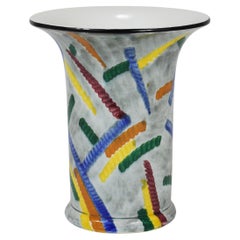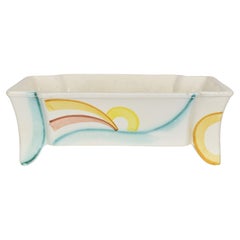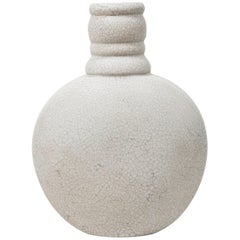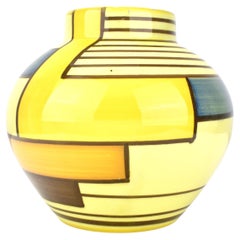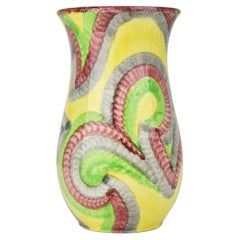Schramberg Majolica Vases and Vessels
to
2
2
2
2
1
2
1
1
1
2
2
2
Height
to
Width
to
2
2
2
4
1,121
560
426
365
Creator: Schramberg Majolica
Eva Zeisel Art Deco Bauhaus Pottery Vase, SMF Schramberg, Germany 1920s
By Eva Zeisel, Schramberg Majolica
Located in Vienna, AT
A colorful and charming Majolica pottery vase from the German modernist Bauhaus era, designed in the late 1920s by Eva Zeisel for the Schramberg Majolika Fabrik (SMF) in Germany. Han...
Category
1920s German Bauhaus Vintage Schramberg Majolica Vases and Vessels
Materials
Ceramic, Pottery
Bauhaus Era Ceramic Bonsai Planter by Eva Zeisel Schramberg Art Deco Avantgarde
By Schramberg Majolica, Eva Zeisel
Located in Bad Säckingen, DE
This exceptional Bauhaus era ceramic bonsai planter or cachepot was designed by the renowned designer Eva Zeisel and produced by the Schramberger Majolika Manufaktur (SMF) in Germany...
Category
1920s German Art Deco Vintage Schramberg Majolica Vases and Vessels
Materials
Ceramic, Majolica
Related Items
Antique Vase From Roger Cuerin Art-Deco Vase in Pottery, Belgium, 1920s
Located in Bastogne, BE
Antique Signed Art pottery vase by Roger GUERIN (1896-1954)
This beautiful art pottery vase is by Roger Guerin, Belgian potter. The colors are shades of tan and chocolate brown....
Category
1920s Belgian Egyptian Vintage Schramberg Majolica Vases and Vessels
Materials
Pottery
French Art Deco Ceramic Vase by Primavera
By Atelier Primavera au Printemps
Located in Paris, FR
French white craquelure vase by Charlotte Chauchet (1878-1964)
for Atelier Primavera au Printemps
Signed Primavera, France,
Numbered.
Category
1930s French Art Deco Vintage Schramberg Majolica Vases and Vessels
Materials
Ceramic
Set of Eva Zeisel Candlesticks, USA 2007
By Eva Zeisel
Located in New York, NY
Rare set of Bronze candlesticks by Eva Zeisel in 2007 at 101 years of age, this is the complete set of sizes at 6”, 8” and 11”, From the “Originals” line, signed to base and no longe...
Category
21st Century and Contemporary American Modern Schramberg Majolica Vases and Vessels
Materials
Bronze
Daum Frères Art Deco Glass Vase, France 1920s
By Daum
Located in Bochum, NRW
Daum Nancy Art Deco Glass Vase, ball-shaped, resting on a round base, with a narrow, flared mouth.
This glass ball vase is made of orang...
Category
1920s French Art Deco Vintage Schramberg Majolica Vases and Vessels
Materials
Glass
WMF Ikora Dinanderie vase. Germany 1920s
By WMF Ikora
Located in Köln, NW
Very rare model of a WMF Ikora Dinanderie vase, Germany 1920s.
According to WMF, some vases and designs were not included in the official range, but sol...
Category
1920s German Art Deco Vintage Schramberg Majolica Vases and Vessels
Materials
Metal, Brass
French Art Deco Ceramic Vase or Small Planter
Located in Miami, FL
This dazzling glazed French Art Deco ceramic vase or small planter was handcrafted. The mixture of colors are truly beautiful.
It can...
Category
Early 20th Century French Art Deco Schramberg Majolica Vases and Vessels
Materials
Ceramic, Pottery
1920s Danish Just Andersen Art Deco Vase
By Just Andersen
Located in Knebel, DK
Danish Just Andersen art deco disco metal vase produced by Just Andersen A/S in the 1940's.
The vase is in good vintage condition and marked with Just. Andersens triangle mark.
Ju...
Category
1920s Danish Art Deco Vintage Schramberg Majolica Vases and Vessels
Materials
Metal
AMPHORA Art Deco Stoneware Vase, Late 1920s
By Amphora
Located in Saint-Amans-des-Cots, FR
Large Art Deco vase by AMPHORA (Turn Teplitz, Bohemia), Czech Republic, late 1920s. This vase was produced for France. Large vase with two small handles. Rotating enameled Art Deco d...
Category
1920s Art Deco Vintage Schramberg Majolica Vases and Vessels
Materials
Stoneware
Art Deco Diskometal Vase Just Andersen, 1920s, Denmark
By Just Andersen
Located in Værløse, DK
Exquisite Diskometal Vase designed by Just Andersen in the late 1920s. It is showcase of Andersens' craftmanship and appeal.
* Diskometal vase in organic shapes.
* Designer: Just An...
Category
1920s Danish Art Deco Vintage Schramberg Majolica Vases and Vessels
Materials
Metal
1940 Vintage Roseville Art Pottery Green Ming Tree 568-8 Rare Bonsai Planter
By Roseville Pottery
Located in San Gabriel, CA
Roseville Ming Tree Green 1949 Mid Century Art Pottery Window Box Planter 568-8. Very good condition. Bottom marked with Roseville, USA and shape number. No chips but very slight gra...
Category
1940s American Art Deco Vintage Schramberg Majolica Vases and Vessels
Materials
Ceramic
$175
H 4 in W 8 in D 1.75 in
Art Deco Bauhaus Bakelite Fruit Bowl Germany, German, 1920s
Located in Nuernberg, DE
An Art Deco Bauhaus Bakelite fruit bowl. Hard to find in this condition, a nice addition to every room or table. It is an vintage original probably fr...
Category
1920s German Bauhaus Vintage Schramberg Majolica Vases and Vessels
Materials
Bakelite
Rare 1950s Eva Zeisel Stoneware Bird Teapot Mid-Century Figural Vessel
By Eva Zeisel
Located in Hyattsville, MD
Early design, whimsical! A bird-form teapot with winged lid, Monmouth Pottery, via Pine Stoneware or Western Stoneware Company in Monmouth, Illinois....
Category
1950s American Mid-Century Modern Vintage Schramberg Majolica Vases and Vessels
Materials
Ceramic
$2,175
H 6.75 in W 8.5 in D 6.5 in
Previously Available Items
Schramberg Eva Zeisel Mondrian Majolica Ceramic Vase Art Deco Bauhaus Era
By Schramberg Majolica, Eva Zeisel
Located in Bad Säckingen, DE
This Schramberg Eva Zeisel Mondrian pattern Art Deco Bauhaus vase is a rare and highly collectible piece of ceramic art. This vase was created in the early 20th Century during the Art Deco period, which was characterized by bold geometric shapes, bright colors, and sleek, streamlined forms. The Bauhaus movement, which began around the same time, was a major influence on the Art Deco style and emphasized the integration of form and function in design.
This Schramberg Eva Zeisel "Gobelin" Art Deco Bauhaus vase is crafted from high-quality majolica ceramic and features an extraordinary hand-painted Art Deco.
Eva Zeisel was a renowned ceramic designer who was active during the Art Deco period, and her designs are highly sought after by collectors today. This Schramberg vase...
Category
1920s German Art Deco Vintage Schramberg Majolica Vases and Vessels
Materials
Ceramic, Majolica
Schramberg Eva Zeisel Gobelin Majolica Ceramic Vase Art Deco Bauhaus Era
By Schramberg Majolica, Eva Zeisel
Located in Bad Säckingen, DE
The Schramberg Eva Zeisel Gobelin Art Deco Bauhaus vase is a unique and highly collectible piece of ceramic art. This vase was created in the early 20th century during the Art Deco period, which was characterized by bold geometric shapes, bright colors, and sleek, streamlined forms. The Bauhaus movement, which began around the same time, was a major influence on the Art Deco style and emphasized the integration of form and function in design.
This Schramberg Eva Zeisel "Gobelin" Art Deco Bauhaus vase is crafted from high-quality majolica ceramic and features an extraordinary hand-painted Art Deco.
Eva Zeisel was a renowned ceramic designer who was active during the Art Deco period, and her designs are highly sought after by collectors today. The Schramberg vase...
Category
1920s German Art Deco Vintage Schramberg Majolica Vases and Vessels
Materials
Ceramic, Majolica
Eva Zeisel Ceramic/Majolica Vases by SMF Schramberg, Set of 4, Marked
By Eva Zeisel, Schramberg Majolica
Located in Los Angeles, CA
Nice set of 4 vases, hand painted and designed for the well known Hungarian artist Eva Zeisel. Made for SMF, Germany. Many pieces were made also in Austria, Hungary. The largest vase...
Category
1930s German Art Deco Vintage Schramberg Majolica Vases and Vessels
Materials
Ceramic, Majolica, Pottery
Art Deco Hand-Painted Schramberg SMF Vase with Vibrant Abstract Patterns
By Schramberg Majolica
Located in New York, NY
This gorgeous vase was realized by Schramberg SMF- one of Germany's most esteemed pottery studios since 1820. It has been meticulously handpainted in to...
Category
1930s German Art Deco Vintage Schramberg Majolica Vases and Vessels
Materials
Pottery
Schramberg Majolica vases and vessels for sale on 1stDibs.
Schramberg majolica vases and vessels are available for sale on 1stDibs. These distinctive items are frequently made of majolica and are designed with extraordinary care. Many of the original vases and vessels by Schramberg Majolica were created in the Art Deco style in germany during the 1920s. If you’re looking for additional options, many customers also consider vases and vessels by WMF Ikora, and Karl Wiedmann. Prices for Schramberg Majolica vases and vessels can differ depending upon size, time period and other attributes — on 1stDibs, these items begin at $834 and can go as high as $1,001, while a piece like these, on average, fetch $918.
